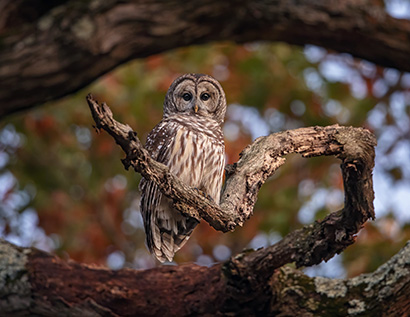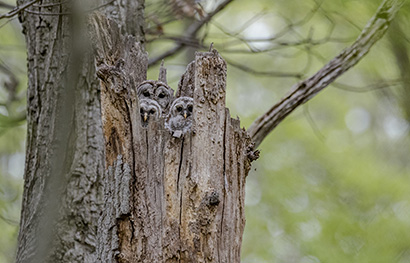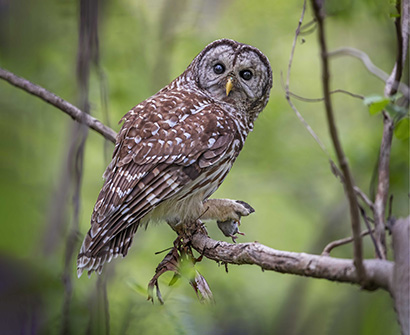Barred Owl
(Strix varia)
Description:
Barred Owls are masters of camouflage, with their gray-brown striped plumage enabling them to blend in with a dense tree canopy. They have a round head, no “ear tufts” on their crown, and large dark eyes. Juvenile Barred Owls are covered in pale, fluffy down when they hatch, and develop their feathers after a few weeks. After they leave the nest, they finish molting into their adult plumage, and at this point, young Barred Owls are nearly indistinguishable from adults. Females are generally slightly larger than males. Barred Owls' plumage is similar between males and females, so distinguishing them can be difficult, but when there is a pair present, the larger owl is likely the female. Barred Owls generally weigh between 1 to 2.5 pounds, are between 16-20 inches long, and have a wingspan between 39-44 inches.

A Barred owl perched on a tree branch. Photo by Scott Suriano, DNR Photo Contest.
Range:
Barred Owls are regarded as one of North America's most common owls. Their range encompasses the entire East Coast of the United States, reaching as far west as Oklahoma, approximately 110° W. They are also found in Southern Canada, and have recently expanded their range into the Pacific Northwest.
Unfortunately, their presence there has led to displacement of, and some hybridizing with, their smaller, less aggressive cousins, the Spotted Owl (Strix occidentalis).
Habitat:
Barred Owl habitats are rather diverse, including swamps, nearby uplands, and streamsides. They prefer to live in established, mature and old growth forest, due to their preference for nesting in dead trees, large tree cavities, and old snags. As long as there is a relatively diverse, healthy forest, they can make their home there. Barred Owls roost in tree cavities, dense branches, or in nest boxes.

A Barred owl and their young. Photo by Jeff Wetzel, DNR Photo Contest.
Behavior:
Barred Owls are very active around twilight. They typically roost quietly in trees during daylight hours, but even so they have been known to call and hunt during the day, and can be seen warming themselves on a sunny forest edge in winter. Barred Owls are rather territorial, and are more assertive during their nesting season. Barred Owls and Great Horned Owls can be found in similar habitats, but Barred Owls avoid the larger, more aggressive Great Horned Owls.
Diet:
Barred Owls are opportunistic predators. The majority of their diet is made up of small mammals such as mice, but they also eat smaller birds, amphibians, reptiles, and invertebrates. They have been known to perch near water and swoop down to catch fish and crayfish.

A Barred Owl holding a mouse. Photo by Scott Suriano, DNR Photo Contest.
Reproduction:
Barred Owls typically do not reproduce until they are at least two years old. While it is not certain, pairs are suspected to mate for life, or are at least behaviorally monogamous. Barred Owls breeding season is from January to August. Males attract females by putting on a display that consists of them swaying their body back and forth, lifting up their wings, and sliding along tree branches. Barred Owls will call out to potential mates with a series of cackles, hoots, caws, and gurgles. Barred Owls breed typically once a year, but they have been known to skip a year, every so often. Females lay approximately 2 to 3 eggs per season. Egg incubation lasts for approximately 28 to 33 days. Juvenile Barred Owls leave their nest after about 4 to 5 weeks, and move along tree branches (known as “branching”) until they are able to fly.
Sounds:
Barred Owls have a distinct call consisting of deep pitched, rhythmic “hoots” that are thought to sound like “Who cooks for you? Who cooks for you all?” They also can have single hoots and during courtship can produce a sound similar to laughter. Males can have deeper pitched calls compared to females. Barred Owls are very vocal, and can be heard year-round, but can typically be heard more frequently in late summer and early fall. Barred Owls also snap their bills as a warning.
Conservation:
Barred Owls are relatively common rangewide, and their global breeding population is estimated to be around 3.5 million individuals. Their population increased 1.1% between 1966 and 2019 per the
Eastern Ecological Science Center's Bird Breeding Survey. Barred Owls are known to outcompete Spotted Owls (Strix occidentalis) in the Pacific Northwest, and have begun to hybridize with them, threatening the Spotted Owl population. Because Barred Owls tend to live in larger patches of mature forest, they are considered to be an indicator species for managing and conserving such habitats and are designated as one of the Forest Interior Dwelling Species (FIDS) in Maryland.
Did You Know?
Barred Owls that prey on crayfish can develop pink-tinged breast feathers!
For More Information: